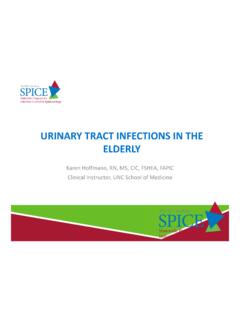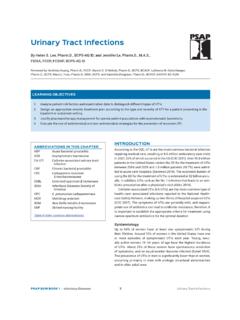Transcription of Commissioning for Quality and Innovation (CQUIN)
1 For 2020 -2021 Publishing Approval Reference Number 001361 NHS England and NHS Improvement Working together for the NHSF ebruary 2020 Commissioning for Quality and Innovation (CQUIN) of Quality and safety services eligibility and and guidance -agreeing and implementing a CQUIN Introduction This document provides the guidance for the Commissioning for Quality and Innovation (CQUIN) scheme for 2020/21. It sets out details of both the CCG and Prescribed Specialised Services (PSS) schemes. Consistent with the approach taken in 2019/20, we are focusing on the spread of good practice, building on success in delivering clinical improvements developed and adopted by colleagues in local, regional and national teams, and which will generate real benefit to patients and providers. The CQUIN design criteriahave been retained, ensuring a continued focus on narrow operational improvements, rather than on complicated and burdensome change.
2 These require that indicators in the scheme: highlight proven, standard operational delivery methods; support implementation of relatively simple interventions; form part of wider national delivery goals that already exist, thereby not adding new cost pressures; are explicitly supported by wider national implementation programmes; and command stakeholder support. We have worked closely with the newly established CQUIN National Design Group, consisting of representatives from partner organisations, helping to test and develop proposals. In addition, each clinical process or method included in the scheme has been tested with a range of providers in order to ensure it is deliverable in the way described, that complexity is removed, and that the learning from existing implementation has been incorporated. All clinical processes and methods are already being adopted nationally, and their inclusion in CQUIN is designed to help draw attention to the benefits and harness the experience of existing adopters to support more rapid uptake.
3 In each case, national support from clinical programmes is in place to help providers to deliver the improvements and build them into normal clinical practice. See later pages for information on how to access this support. In some areas priority has been given, exceptionally, to promoting through CQUIN the robust recording of clinical activity. These areas will be included in the scheme for the minimum time required to improve reporting, enabling a transition to clinical indicators when the infrastructure to measure uptake is in place. Payment rules continue to promote simplicity, with lower and upper adoption goals for each intervention chosen to ensure CQUIN funding is fully earnable, building on current adoption and acknowledging the variation that already exists between Overview of Quality and safety Overview of Quality and safety indicatorsThe 2020/21 CCG and PSS CQUIN schemes comprise indicators, aligned to 4 key areas as below, all of which directly support delivery of the Long Term Plan.
4 Descriptions of each intervention are contained on the following of ill healthMental healthPatient safetyBest practice Overview of Quality and safety CCG schemeThe CCG CQUIN scheme highlights the below repeatable methods and interventions selected from current delivery goals across all provider types, aligned under four priority areas. All have been reviewed to ensure they are in line with current routine clinical practice, and are simple and straightforward to implement. National programme teams are supporting implementation by making available practical tools, training and of ill health Appropriate antibiotic prescribing for UTI in adults age 16+ Cirrhosis and fibrosis tests for alcohol dependent patients Malnutrition screening Oral health assessments Staff flu vaccinationsMental health Use of anxiety disorder specific measures in IAPT Outcome measurement across specified mental health services Biopsychosocial assessments by MH liaison servicesPatient safety Recording of NEWS2 score, escalation time and response time for unplanned critical care admissions Screening and treatment of iron deficiency anaemia in patients listed for major elective blood loss surgery Assessment.
5 diagnosis and treatment of lower leg wounds Assessment and documentation of pressure ulcer riskBest practice pathways treatment of community acquired pneumonia in line with BTS care bundle Rapid rule out protocol for ED patients with suspected acute myocardial infraction (excluding STEMI) Adherence to evidence based interventions clinical criteria Access to patient information at scene Data security protection toolkit compliance, and reported access to NHS mailDetailed specifications can be found Applicable indicators will depend on the type of CCG schemeThe following table shows how the supported methods and interventions are relevant to the providers of different services. More information on each is contained in section All national indicators must be adopted where the relevant services are in scope for each contract, and their value should be equally weighted across the CQUIN funding available. This means if there are 5 indicators relevant for a provider, each wouldbe worth (ensuring the scheme is worth of the Actual Annual Value in total).
6 Where fewer than three national indicators are readilyapplicable to a particular contract, CCGs may offer additional local CQUIN indicators (of appropriate number and complexity, proportionate tothe scale of the contract).AcuteMental healthCommunityCare homesAmbulanceRecording of NEWS2 score, escalation time and response time for unplanned critical care admissionsUse of anxiety disorder specific measures in IAPTA ssessment, diagnosis and treatment of lower leg woundsOral health assessmentsAccess to patient information at sceneTreatment of community acquired pneumonia in line with BTS care bundleOutcome measurement across specified mental health servicesMalnutrition screening Malnutrition screeningStaff flu vaccinationsAppropriate antibiotic prescribing for UTI in adults aged 16+Biopsychosocial assessments by MH liaison servicesAssessment and documentation of pressure ulcer riskAssessment and documentation of pressure ulcer riskCirrhosis and fibrosis tests for alcohol dependent patientsCirrhosis and fibrosis tests for alcohol dependent patientsStaff flu vaccinationsData security protection toolkit compliance.
7 And reported access to NHS mail (also applicable to CCG commissioned domiciliary care providers)Rapid rule out protocol for ED patients with suspected acute myocardial infraction (excluding STEMI)Staff flu vaccinationsScreening and treatment of iron deficiency anaemia in patients listed for major elective blood loss surgeryAdherence to evidence based interventions clinical criteriaStaff flu Overview of Quality and safety indicators PSS schemePSS areas included within CQUIN have been simplified in line with the approach taken to the CCG scheme. The design of the scheme has been streamlined, with significantly fewer national indicators than in the 2019/20 scheme. All have been reviewed to ensure they are in line with current routine clinical practice, and are simple and straightforward to implement. National programme teams are supporting implementation by making available practical tools, training and of ill health Hep C elimination Managing a healthy weight in adult secure MH servicesMental health CAMHS needs formulations in inpatient and community services D/deaf communications assessments in CAMHS and adult inpatient services Routine outcome monitoring in perinatal inpatient servicesPatient safety Antifungal stewardshipBest practice pathways Paediatric movement therapy Severe asthma Shared decision makingDetailed specifications can be found CCG schemeHighlighted good practice selected for Prevention of ill healthHighlighted action/ methodBenefit deliveredSupport and informationCCG1: Appropriate antibiotic prescribing for UTI in adults aged 16+Applicability: All providers of acute goal: 40% to 60%Supporting ref.
8 NICE Guidance NG113& NICE Quality Standard QS90 There is established NICE / Public Health England guidance for the appropriate prescribing of antibiotics to treat urinary tract infection (UTI), including pyelonephritis and catheter associated infection (CAUTI). Improving the diagnosis and management of UTI, including review of catheter use, will reduce treatment failure, risk of healthcare associated bacteraemia, and reduce associated length of stay. In particular, better prescribing will improve the diagnosis & treatment of the estimated 38,000 hospital associated CAUTIs which lead to a further 2,500 catheter associated blood stream infections (CABSI) each year. CAUTIs incur 46,000 excess bed days and 1,500 deaths each year. Supporting documents will be available on the Antimicrobial Resistance Future NHS Collaboration Platform. For access please contact the email address below. Contact Elizabeth Beech at Cirrhosis and fibrosis tests for alcohol dependent patientsApplicability: All providers of acute and MH goal: 20% to 35%Supporting ref: NICE Guidance NG49 & NICE Guidance NG50 The NHS E/I prevention team, in partnership with Public Health England have been using CQUIN over recent years to ensure that effective screening and brief interventions are in place for those drinking at at risk levels.
9 This indicator builds on the improved screening rates, and draws attention to evidence that earlier diagnosis can improve outcomes, so focuses on improved uptake of cirrhosis and fibrosis tests. In 2016/17, more than 50,000 liver admissions were unplanned and avoidable. Improved cirrhosis and fibrosis testing will increase the number of liver disease diagnoses, which will change patient behaviour in time for more effective treatment and better prospects of recovery supporting a reduction in the burden that liver disease places on the NHS. Supporting documents will be available here Contact Alice Rose O Connell at Prevention of ill healthHighlighted action/ methodBenefit deliveredSupport and informationCCG3: Malnutrition screeningApplicability: All providers of community inpatient services and care homes with NHS funded goal: 50% to 70%Supporting ref: NICE Quality Standard QS24 Malnutrition is a common clinical and public health problem in England, which is found in all care settings, all disease categories, and individuals of all ages.
10 In 2011 2012 The National Institute for Health Research estimated the cost of malnutrition to be billion in England. It is estimated to affect 5% of the adult population in England, and is expected to increase with the aging population. This indicator builds on work carried out through the nutrition improvement collaboratives, and supports simple screening for malnutrition using a validated tool, such as The Malnutrition Universal Screening Tool . Improved screening is expected to support prevention, identification and treatment , enabling potentially significant reductions in both the clinical and economic burden of malnutrition, linked to associated increased admissions and LOS in hospital. Supporting documents will be available on the Ageing Well Future NHS Collaboration Platform. For access please contact the email address below. Contact Alexander Thompson at Oral health assessmentsApplicability: All care homes with NHS funded goal: 30 to 50%Supporting ref: NICE Guidance NG48, NICE Oral Health Assessment Tool, NICE guidance exists to undertake oral health assessments, however audit work by CQC has established that there is variable uptake of recognised tools in order to undertake the assessment.












